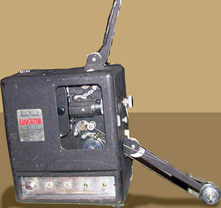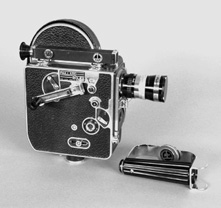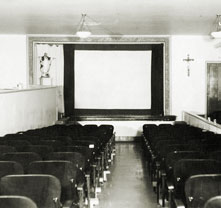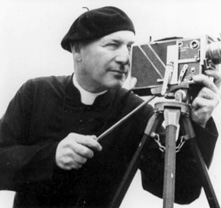16 mm
-

16mm sound projector of Canadian design, manufactured around 1950 by Northern Tool and Gauge.
Source : Cinémathèque québécoise, 1993.0328.01-02.AP.01
-

16mm Bell and Howell Filmo 70D camera manufactured around 1930.
Source : Cinémathèque québécoise, 1993.0193.01-04.AP.01
-

Swiss 16mm Paillard-Bolex camera.
Source : Cinémathèque québécoise, 2008.0008.01-04.20.AP.01
-

Religion was a powerful presence in this parish hall fitted out for film screenings.
Source : Pierre Pageau
-

Maurice Proulx and his faithful 16mm Cine-Kodak Special camera.
Source : Cinémathèque québécoise, 2000.0039.PH.01
Film history has seen the use of various gauges or formats. Some had limited success, while others were widely accepted; 35mm, for example, became the standard gauge in 1909 and is so still today. A desire to develop semi-professional and amateur cinema led companies to market smaller gauges. Of these, the principal gauges, for both filming and projection, were the 28mm stock launched by Pathé in 1913 and, in 1922, its 9.5mm stock, with a single perforation between images in the centre of the strip of film; Kodak replied in 1923 with 16mm stock, with two rows of perforations along the edges, which was reduced to one row along one edge for sound film, and, in 1932, with 8mm, originally made out of 16mm stock by doubling the number of perforations and splitting the film in two for projection.
Pathé’s 9.5mm and Kodak’s 8mm stock were intended mostly for home use, while 16mm was adopted by amateurs and non-professionals and was also used as a non-commercial distribution format. Like every other small-gauge film stock, 16mm was non-inflammable. Unlike 35mm, whose nitrate celluloid base required that it be used only in projection booths fitted out for fire safety, 16mm films could be projected anywhere. The NFB’s community distribution network thus used 16mm, as did films intended to be shown in schools.